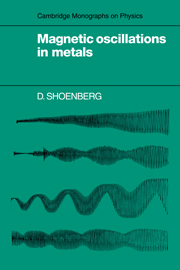Book contents
- Frontmatter
- Contents
- Preface
- List of symbols and abbreviations
- 1 Historical introduction
- 2 Theory
- 3 Observation of the de Haas–van Alphen effect
- 4 Other oscillatory effects
- 5 Fermi surfaces and cyclotron masses
- 6 Magnetic interaction
- 7 Magnetic breakdown
- 8 The Dingle temperature
- 9 Phase and spin-splitting
- Appendices
- Bibliography and author index
- Notes added in proof
- Subject index
- Frontmatter
- Contents
- Preface
- List of symbols and abbreviations
- 1 Historical introduction
- 2 Theory
- 3 Observation of the de Haas–van Alphen effect
- 4 Other oscillatory effects
- 5 Fermi surfaces and cyclotron masses
- 6 Magnetic interaction
- 7 Magnetic breakdown
- 8 The Dingle temperature
- 9 Phase and spin-splitting
- Appendices
- Bibliography and author index
- Notes added in proof
- Subject index
Summary
It is just over 50 years ago that an oscillatory magnetic field dependence was first observed in the electrical resistance of bismuth by Shubnikov and de Haas and in the magnetization by de Haas and van Alphen. It was not long before Peierls showed how these effects could be understood in principle and, indeed, Landau had implicitly predicted oscillatory behaviour even before the experimental discovery, but the effects remained somewhat of a scientific curiosity for upward of 20 years. It was only in the 1950s with the observation of magnetic oscillations in many metals other than bismuth and the advent of improved theoretical understanding that it began to be realized that the effect was not only an aesthetically pleasing curiosity but potentially a powerful tool for understanding the electronic structure of metals.
During the following 20 years, exploitation of this possibility became somewhat of a ‘band wagon’ and with ever improving experimental and theoretical techniques, an immense amount of detailed information about the ‘Fermiology’ of individual metals has emerged. More recently the pace has slackened, though there are still many loose ends and unsolved problems, and during a sabbatical half year at the University of Waterloo in 1977, I felt the time was ripe for a new comprehensive review and somewhat light-heartedly embarked on it little thinking it would be five years before it was ready for the Press.
- Type
- Chapter
- Information
- Magnetic Oscillations in Metals , pp. xi - xviPublisher: Cambridge University PressPrint publication year: 1984



